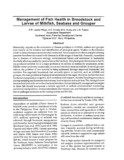Nutrient flow and physicochemical profile studies of an integrated poultry-salt-Artemia-milkfish-sea bass-shrimp pond production system
| dc.contributor.author | Jumalon, Nepheronia A. | |
| dc.contributor.author | Ogburn, Damian M. | |
| dc.contributor.editor | Sorgeloos, Patrick | |
| dc.contributor.editor | Bengtson, David A. | |
| dc.contributor.editor | Decleir, Walter | |
| dc.contributor.editor | Jaspers, Edmonde | |
| dc.date.accessioned | 2011-06-22T09:35:09Z | |
| dc.date.available | 2011-06-22T09:35:09Z | |
| dc.date.issued | 1987 | |
| dc.identifier.citation | Jumalon, N. A., & Ogburn, D. M. (1987). Nutrient flow and physicochemical profile studies of an integrated poultry-salt-Artemia-milkfish-sea bass-shrimp pond production system. In P. Sorgeloos, D. A. Bengtson, W. Decleir, & E. Jaspers (Eds.), Artemia Research and its Applications (Vol. 3. Ecology, Culturing, Use in Aquaculture, pp. 239-251). Wetteren, Belgium: Universal Press. | en |
| dc.identifier.uri | http://hdl.handle.net/10862/295 | |
| dc.description.abstract | The physicochemical and biological parameters of an integrated flow-through poultry-salt-Artemia-milkfish-sea bass-shrimp pond production system were monitored for 6 months to determine the pattern of nutrient changes and associated plankton communities as water passed through the system. A 20 ha salt farm in Negros Oriental, Philippines, was used as a model of the integrated system. The construction of a poultry farm at the inlet reservoir provides continuous fertilization and allows considerable control of nutrient inputs to the pond system. Nutrients increase markedly in the chicken pond and in subsequent ponds undergo cycles of biological assimilation and bacterial mineralization. Principal component analysis ordinates temporal and spatial changes in 33 variables that were monitored. Using scatter diagrams of the principal components enabled separation of ponds adjacent to the crystallization bed and ponds high in fish biomass from the rest of the system. Variables that served to numerically delineate the ponds in this manner were salinity, phosphate, ammonia, alkalinity, turbidity, acidity, microplants, pico- and nannoplankton. The implications of this ordination in relation to pond management techniques is discussed. | en |
| dc.language.iso | en | en |
| dc.publisher | Wetteren, Belgium: Universal Press | en |
| dc.subject | Chanos chanos | en |
| dc.subject | Artemia | en |
| dc.subject | Lates calcarifer | en |
| dc.subject | Crustacea | en |
| dc.subject | Planktons | en |
| dc.subject | nutrients | en |
| dc.subject | Philippines | en |
| dc.subject | prawns and shrimps | en |
| dc.subject | milkfish | en |
| dc.subject | Brine shrimps | en |
| dc.subject | sea bass | en |
| dc.subject | Giant tiger shrimp | en |
| dc.subject | Penaeus monodon | en |
| dc.subject.lcc | VF SP 77 | |
| dc.title | Nutrient flow and physicochemical profile studies of an integrated poultry-salt-Artemia-milkfish-sea bass-shrimp pond production system | en |
| dc.type | Conference paper | en |
| dc.citation.spage | 239 | |
| dc.citation.epage | 251 | |
| dc.citation.conferenceTitle | Artemia research and its applications: Vol 3. Ecology, Culturing, Use in Aquaculture. Proceedings of the Second International Symposium on the Brine Shrimp Artemia, 1-5 September 1987, Antwerp, Belgium | en |
| dc.subject.asfa | food fish | en |
| dc.subject.asfa | milkfish culture | en |
| dc.subject.asfa | sea bass culture | en |
| dc.subject.asfa | shrimp culture | en |
| dc.subject.asfa | brine shrimp culture | en |
| dc.subject.asfa | physicochemical properties | en |
| dc.subject.scientificName | Penaeus monodon | en |
| dc.subject.scientificName | Chanos chanos | |
| dc.subject.scientificName | Lates calcarifer | en |
Files in this item
| Files | ขนาด | รูป | View |
|---|---|---|---|
|
There are no files associated with this item. |
|||
รายการนี้ปรากฏใน (s)
-
Conference Proceedings [298]



